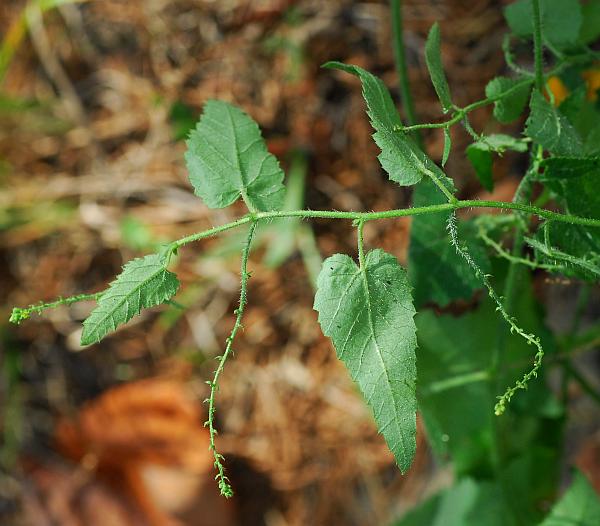Tragia cordata (Harv.) Burtt Davy
Heart-Leaved Tragia

Native
CC = 9
CW = 5
MOC = 5
SRank = S2
© SRTurner
Tragia cordata (Harv.) Burtt DavyHeart-Leaved Tragia | |
 |
Native CC = 9 CW = 5 MOC = 5 SRank = S2 |
© SRTurner |
|
Family - Euphorbiaceae Habit - Perennial forb. Stems - From a woody caudex, herbaceous, pubescent and with stinging hairs, vining, to 1.5 m long.
Leaves - Alternate, stipulate, petiolate. Stipules spreading, ovate to lanceolate, to 5mm long, 3mm broad, with stinging hairs. Petioles to +/-5cm long, with same pubescence as stem. Blades cordate, dentate, +/-10cm long, 6.5cm broad, sparsely pubescent above and below and with stinging hairs, dark green above, silvery-green below. Lowest leaves broadly ovate.
Inflorescence - Axillary raceme to 4cm long in flower, expanding in fruit, androgynous. Each flower subtended by a small bract. Bract linear, rounded at apex, 1.1mm long. Pedicels 2mm long in flower, slightly longer in fruit, sparse glandular pubescent.
Flowers - Staminate flowers with 3 erect stamens. Filaments green, fleshy, glabrous, 0.3 mm long. Anthers yellow, 0.1 mm broad. Sepals 3, green, spreading, mostly glabrous or with a few hairs near the apex, oblong elliptic, 1.2mm long, 1mm broad, subacute. Petals none. Pistillate flowers with 5-7 sepals. Sepals accrescent. Styles united in lower 1/2. Stigmas purple, persistent. Capsule 3-carpellate, (1-seed per carpel), stinging pubescent. with evident green venation, +/-1.5cm broad.
Flowering - June - September. Habitat - Bottoms, rocky open woods, thickets, glades. Origin - Native to the U.S. Lookalikes - None. Other info. - This interesting plant has been recorded as rare in Missouri in the past but if you get out and look for it you will find the plant in many of the Ozark counties. This species is fairly indistinct and is more often felt than seen. The stinging sensation of the plant takes a few moments to reach its maximum but is quite painful. Dan Tenaglia described the stinging as "about as much pain as you can have without actually being hurt." Photographs taken at the Current River Conservation Area, Reynolds County, MO., 6-29-01, and in the Peck Ranch Wildlife Refuge, Carter County, MO., 7-12-03 (DETenaglia); also along the Glade Top Trail, Taney County, MO, 9-23-2017 (SRTurner). |